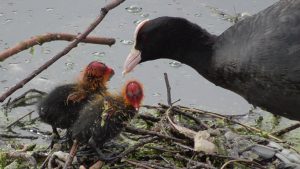Celebrating “common” wildlife.
At The Friends of Sheepwash, we recognise that most people’s interaction with urban wildlife comes from feeding wildfowl on the lakes, and that they are not necessarily interested in the rare or illusive to find.
In this regard, we are keen to encourage families to the site with their children as it is important that the young make connections with wildlife. This early experience will hopefully foster and shape a desire to protect and respect their habitats later in life.
We started a “swanwatch” scheme at the site in the early 2000’s, which was really a wildlife watch scheme across the whole reserve. It was launched by the then Mayor and local Great Bridge councillor Jean Marson.
This page looks at some of the ways in which you can help your feathered friends at Sheepwash, and also gives more information about six of the more visible birds at the reserve.
FEEDING- What do birds like to eat?
Most wildfowl eat a vegetarian diet of plants and weeds in the lakes and on the River at Sheepwash. They do however enjoy food given to them by members of the public, and this is particularly important in the Winter months when natural food may be scarce.
There has been much vocal debate about this subject, and we do not agree with blanket statements such as “bread is bad”, as our experience is informed by many years of rescue activity, as well as direct liaison with people of 40+ years of wildfowl rehabilitation such as Jan Harrigan of Wychbold Swan Rescue. You can read more about this debate, and some of the debunked myths HERE.
That being said, we would encourage people feeding the birds at Sheepwash to offer a variety of food and not just bread, such as
- Lettuce
- sweetcorn
- porridge oats
- cereals
- mixed corn
- wildfowl pellets
NEVER FEED BIRDS ANY MOULDY FOOD AS THIS COULD CAUSE THEM SERIOUS HARM, AND IF THEY HAVE FOOD ALREADY, PLEASE RECOGNISE THAT THEY DO NOT NEED ANY MORE.
The following picture is one which needs no explanation, and illustrates this point.
MUTE SWANS
These large white, often clumsy birds are resident breeders, and also visit the site in usually larger numbers in Autumn and Winter.
A male swan is called a cob, with the female a pen. Although called “mute”, they can make a range of sounds, including a special one associated with talking to their young, which are called cygnets.
Cobs tend to be slightly bigger with a larger black “berry” on their head, and may also have a flatter head.
Swans have many myths associated with them such as “they mate for life, and that they can “break your arm with their wings”. Neither of these statements are true.
Swans lay around 4-10 eggs in late February into March , usually hatching in May. One egg is laid every other day on a nest built by the cob, and after all eggs have been laid, the pen incubates them for around 36 days before they hatch.
After about three days, the cygnets take to the water for the first time, and can often be seen riding on the backs of their parents. The spot on the end of their beak is probably used as a recognition point during early bonding and imprinting.
Adult swans start to loose their flight feathers around June, which enables them to regrow old soiled feathers corresponding with their young’s new found ability to fly. From late September, cygnets begin to learn to fly, with often hazardous consequences.
Swans can live over 20 years , though with many threats their life expectancy is nearer half of this.
CANADA GEESE
The chances are, you will hear these comedic characters before you see them, honking their arrival on landing , or calling territory on other pairs on parts of the lake. We love geese, and they are an integral part of the site.
A Canada goose male is called a gander, with a female being known as a goose. Ganders usually make a loud long honking noise, with the females making a short honk rhythm accompaniment.
Nesting takes place in February- May usually, with chalky eggs being laid on sparsely covered nests made mostly of the birds down feathers.
The young yellow hatchlings are called goslings, and the geese are well known for family groups coming together for protection in creches guarding their young ones. Many however are still predated by gulls, crows and foxes without fledging. After around 3 months, the birds start to learn to fly, and will remain in their family flock group for some time.
We have produced a factsheet about this very misunderstood and maligned bird, and also check out the longstanding campaign against culling, when Sandwell council made the very serious error of targeting these birds for spurious reasons in 2013/14.
DOWNLOAD OUR CANADA GOOSE FACTSHEET HERE.
MALLARDS
The most common duck on Sheepwash can be found on the pools and The River Tame, in flight, paddling and waddling between them.
Males are called drakes and have bottle green heads with a white ring and chocolate brown breast. Female ducks are brown with an orange bill.
Often ducks nest in unusual places, such as on roofs and buildings, and this requires the ducklings to make leaps of faith into the water , called by the mother. They are also known to travel some distance from the nest to find water, and often get into trouble falling down drains and other watercourses.
Heavy predation by gulls is sadly common, and although numbers of hatching birds may be high when first seen, these are quickly diminished. Surviving ducklings can fly after around 7 to 8 weeks.
TUFTED DUCKS
More shy than mallards, these diving ducks have distinctive yellow eyes, with the male being black with white sides, and the characteristic tuft on the back of the head. Females are a chocolate brown colour.
Ducklings usually hatch later in the year than the first mallard broods, and the female can be heard giving a barking quack. They are also heavily predated by gulls.
MOORHENS
Moorhens are distinguishable from coots on account of their red bill with yellow tip. They are very agile and secretive birds, often hiding in reeds or low tree cover. They may have up to three broods in a year, and chicks hatch after around 20 days.
Fat males will posture by showing off their rear ends when threatened by rivals. They will also spar with their legs in territorial disputes.
COOTS
Coots are bulkier than moorhens with a white frontal “shield” and bill. They are known to be fearsome characters and will stand up to much larger birds such as swans if they feel their nests or young are threatened. They also fight one another by using their legs in boxing matches.
They can build large nests and are very active in fetching materials from distance including litter to form them. Eggs hatch after around 21-24 days.
 Coots are some of the best parents, doting on their young even when they are able to feed for themselves. Juvenile coots will still call for food and be attentively served. They may also help out with the next brood staying with the family group and parents.
Coots are some of the best parents, doting on their young even when they are able to feed for themselves. Juvenile coots will still call for food and be attentively served. They may also help out with the next brood staying with the family group and parents.














